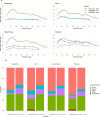Characterizing social behavior relevant for infectious disease transmission in four low- and middle-income countries, 2021-2023
- PMID: 41168147
- PMCID: PMC12575605
- DOI: 10.1038/s41467-025-64850-9
Characterizing social behavior relevant for infectious disease transmission in four low- and middle-income countries, 2021-2023
Abstract
Infectious diseases account for nearly half of all child mortality worldwide, with most of the burden concentrated in low and middle-income countries (LMIC). Person-to-person interactions, or 'contacts', facilitate the spread of respiratory and enteric pathogens. The number and nature of contacts likely vary across countries along with social and cultural norms, but few studies have compared behaviors across countries and none have done so with a focus on children. Here we present data from a population-based study conducted from 2021 to 2023 in Guatemala, India, Mozambique, and Pakistan. Across four countries, 5085 participants reported a total of 84,829 contacts across two days. Mean contact rates were highest among 10- to 19-year-olds except in Pakistan, where contacts were highest among 5- to 9-year-olds. Non-home locations which presented high risk for transmission were schools in India, workplaces in Pakistan, and 'other' social / leisure locations in Mozambique and Guatemala. Among children under 5 years of age, the proportion of contacts with non-household members was highest in Mozambique and lowest in India; most of these were reported at home. Contact patterns by age diverge from prior projections that are extrapolated from contact data from high-income countries, underscoring the value of local data collection.
© 2025. The Author(s).
Conflict of interest statement
Competing interests: The authors declare no competing interests.
Figures




References
-
- Global health estimates: Leading causes of death. https://www.who.int/data/gho/data/themes/mortality-and-global-health-est... (2000–2021).
MeSH terms
Grants and funding
LinkOut - more resources
Full Text Sources
Medical

